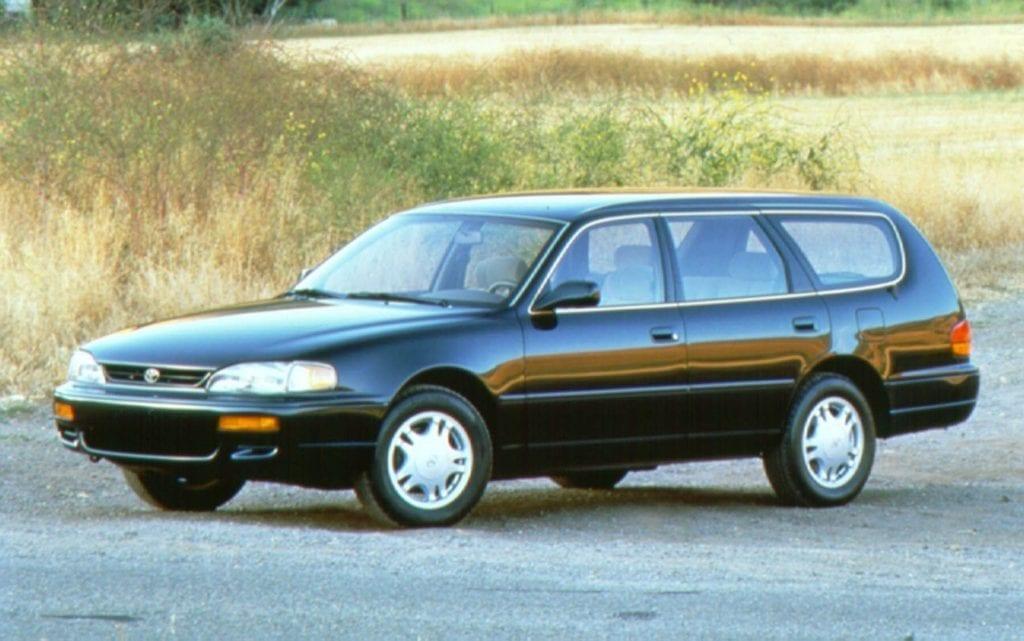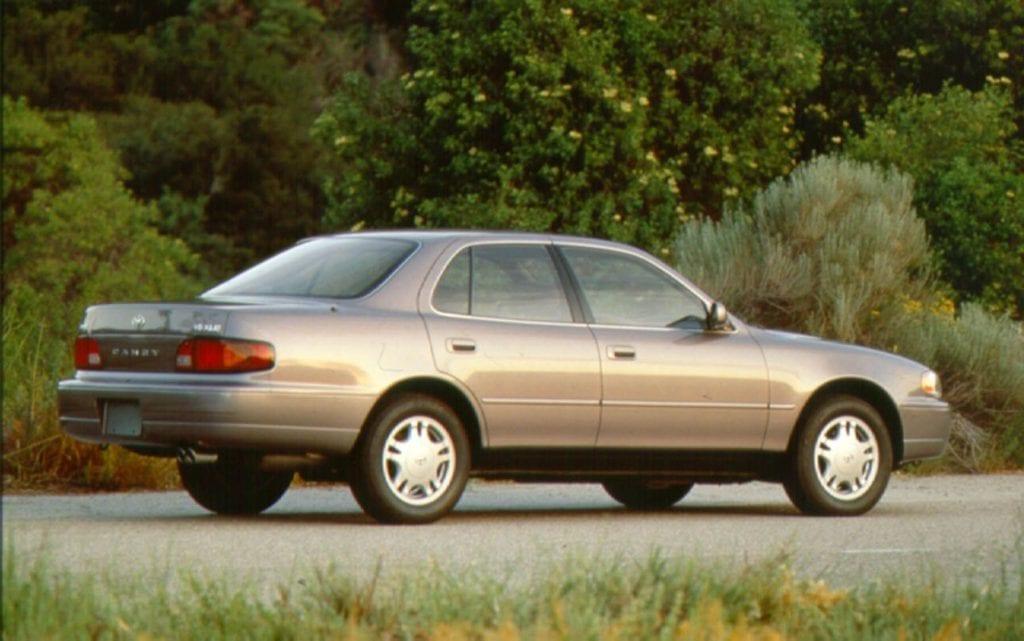The XV10 Toyota Camry is a Used Car Hidden Gem

Paint fades, that new car smell wafts away, upholstery wears, and dings and dents are inevitable. Great used cars don’t avoid those indignities, they wear them as battle scars. They’re indomitable and intrepid, reliable and resilient, and cheap to keep on the road. A great used car has an aging nobility to it.
And the greatest used car of them all is the third-generation Toyota Camry (1992-1996). Here’s how it got to be that.
Earlier Camrys
Let’s regress to the 1980s. A different time.
Back then the North American vehicle market was still dominated by sedans. There was no such thing as a crossover, SUVs were mostly bought by the Forest Service and geology professors, and using a pickup every day wasn’t practical for most families. Minivans were still popular, but their stigma as mom-mobiles was already entrenched. But conventional sedans – four doors for easy passenger access and a trunk where your valuable stuff could be stored under a locked steel lid – made perfect, intuitive sense to late-20th century humanity.

Toyota introduced the front-drive Camry model (pictured above) as a replacement for the rear-drive Corona sedan for the 1983 model year. Built in Japan with the squared-off styling of a Lego brick, the Camry was instantly popular in the United States.
“Toyota has made little attempt to sway the masses with European inspiration this time around,” Car and Driver wrote in its May 1983 issue about this mainstream sedan. “What we have here is the American car according to Japan, in its purest form ever.” But it was still Japanese.
At about the same moment that first Camry was shipped to America, in November of 1982 Honda began building its Accord in Ohio. And then the 1986 model year brought with it the paradigm shattering, immensely popular, almost-futuristic Ford Taurus and an all-new sleeker Accord that threatened to bury the dowdy Camry. Maybe it was a coincidence (maybe it wasn’t) that 1986 was also the year that Toyota announced it was forming Toyota Motor Manufacturing of Kentucky to build its first wholly-owned and controlled assembly plant in the United States. And the product that would be built in that new plant was the Camry.

The second-generation Camry (pictured above), the first built at the Georgetown, Kentucky plant starting in 1988, was okay enough. But it was conservative and identical to the Camry built in Japan. Toyota’s all-out effort would come with our hero, the third-generation 1992 Camry.
Debut of the XV10
With marketing lessons learned from the launch of its Lexus division in mind, the 1992 Camry – code named XV10 inside Toyota – was way better than it needed to be. This wasn’t Toyota looking to maximize profits, but to grab market share. To make a car so good and sell it at such an attractive price, that it would shatter expectations and drag buyers away from the Accord and Taurus. If Toyota made any money selling the over-built XV10, it wasn’t a lot.

Look at how the doors of the 1992-1996 Camry (pictured above) roll over up into the roof. That’s a lot like those of the then-current Lexus LS400, and it allowed Toyota to add an outer seal beyond the expected initial seal that made the car quieter. Close the door on an XV10 Camry, and it seals like Tupperware to lock in that stay-fresh goodness.
Compared to the Japanese market Camry, built to that country’s size regulations, the XV10 was wider and slightly longer to meet North American tastes. Toyota was building, for the first time, a truly American car.
Inside the XV10 was all restrained styling and thickly padded, finely grained plastics that feel substantial. The switches all operated like surgical instruments, and the control design was so logical it could have been teaching rhetoric at the University of Chicago. It looked simple and elegant, but developed to nth-degree refinement. The 1992 Camry was everything Toyota knew about building cars applied to the task of attracting American buyers.

But while all that design goodness made the Camry attractive, it was only the start of what keeps the XV10 at the top of the used car pile. The 1992-1996 Camry is still great to drive and has proven itself bulletproof.
Under the Hood
The base engine in the 1992 Camry sedan was the 2.2-liter “5S-FE” inline four-cylinder engine. Rated at only 135-horsepower in the Camry, it didn’t produce scintillating performance. That was, however, beside the point. The 5S-FE was the then-latest version of the Toyota S-Series engine family that had been around since 1980. And Toyota shoved S-Series fours into everything from sporty Celica coupes to RAV4 crossover SUVs. Massively turbocharged to produce up to a reported 671-horsepower, versions of the S-Series four even powered AAR Eagle Mk. III mid-engine prototypes in IMSA GTP racing during the early 1990s.
Toyota built the S-Series engines to be bulletproof. They used a stout iron cylinder block and an alloy head fitted with dual overhead camshafts (DOHC) and four valves per cylinder. In the Camry it was seriously understressed, loafing along with a 9.5:1 compression ratio and rarely being tasked with spinning beyond its 4400 rpm torque peak. No engine is indestructible, but the fuel injected 5S-FE is close.
While the XV10 Camry was offered with a five-speed manual transmission, the vast majority were equipped with the optional four-speed automatic. Both gearboxes are also renowned for reliability.

Anyone wanting more power or more refinement in their Camry could pay extra for the “3VZ-FE” 3.0-liter V6 rated at 185-horsepower. Also using an iron block and DOHC alloy cylinder heads, this engine creamy smooth enough to also be used in the original Lexus ES300. For the 1994 model year it was replaced by the new “1MZ-FE” 3.0-liter V6 that used a lighter weight aluminum block and saw output rise to 188-horsepower.
The V6s don’t have quite the same reputation for indomitable reliability that the fours do, but with regular maintenance, they’re good for several hundred thousand miles of service. In the Camry virtually all of them were lashed to four-speed automatic transmissions.
A Sales Leader
For Toyota, the bottom line was the bottom line and the 1992 Camry sold astonishingly well. Available in base, DLX, LE and posh XLE trim levels, a total of 284,751 Camry sedans were sold in America that model year. That was about 20,000 units more than in 1991, even if it was more than 100,000 behind the Honda Accord’s sales. But Toyota wasn’t done with the XV10 and added a new wagon model in 1993 and a two-door coupe in 1994.

So in 1993 Toyota sold 297,836, then 319,718 in 1994, 326,632 during 1995 and 357,359 for 1996. That 1996 number is only 25,000 units behind what the Accord sold. It was also only about 37,000 cars behind the Taurus. The XV10 Camry had done exactly what Toyota had wanted it to do: take market share. With that beachhead established, after the next generation Camry, the XV20, was introduced for 1997, the Camry would pass the Accord in sales. During the 1998 model year, the Camry’s sales grew to a massive 427,308 units and the Toyota was outselling the Taurus too – by more than 95,000 cars.
The reputation and quality of the XV10 is the base upon which the Camry’s sales success is built. And it’s been the first or second best-selling car in America ever since – though more pickups and crossovers dominate the market now.
Because the XV10 sold in such massive numbers, parts are easy to find and usually inexpensive. And resale values have always been outstanding. Particularly in states like California where roads aren’t salted during the winter, the XV10s remain structurally solid even now, 23 years after the last one was produced.

In fact XV10s are so common in California and other western states that they still blend in. When was the last time you saw a 1997 Taurus still being daily driven?
It’s only a rough measure of the market, but as this is written there are 53 XV10 generation Camrys listed on Autotrader for sale. They range from a creampuff 1995 Camry LE with V6 power and only 79,000 miles on the clock for $3,650 to an $800 l993 LE showing more than 325,000 miles on its odometer. An $800 XV10 is still a pretty good bet to go at least another 10,000 miles.
The Bottom Line
As used cars go, the XV10 is the prime mover. It’s the yardstick by which other used cars are measured and the standard of quality that has set Toyota’s course for more than a quarter century. It’s an ordinary car that has earned its extraordinary reputation. The XV10 is the essence of Toyota at its peak – the embodiment of all things Toyota.

Subsequent generations of Camrys have also been fine and rugged machines. But Toyota added compromises to all of them as it pulled back from maximizing market share and concentrated on profits.
They’re good, but they just aren’t the XV10.
Photos courtesy of Toyota